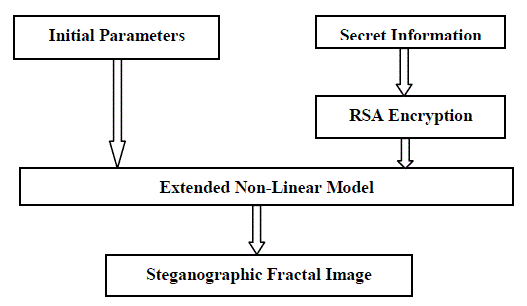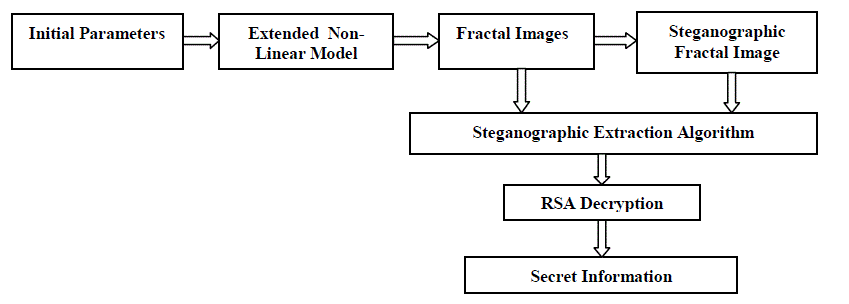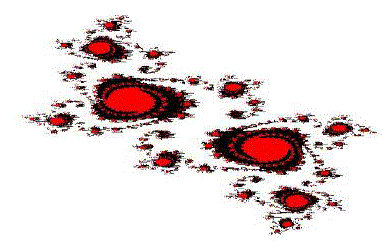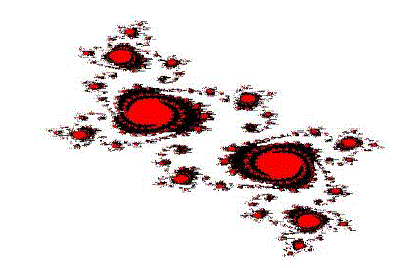Keywords
|
| Steganography, Fractal Image, Hausdorff, Escape Time Algorithm. |
INTRODUCTION
|
| Steganography is the art and science of hiding information by embedding messages within other digital multimedia objects, ostensibly harmless message. Steganography means “covered writing” in Greek. The steganography goal is to hide the presence of a message within another message called cover message [1-3]. So steganography can be seen as the complement of cryptography whose goal is to hide the content of a message. Steganalysis is the counterpart of steganography, as its goal is to detect the presence of hidden data. |
| The carriers commonly used include images, videos, audios, texts, two dimensional bar codes. Therefore, steganography in images, especially in natural images is popular. However, the natural images themselves exist as a kind of noise, which will significantly affect the embedding capacity of the steganography system. Generally, the carrier images can be downloaded conveniently from internet by anyone, including the attacker. The traditional natural image steganography often changed the inherent statistical characteristics which the original carrier images have, especially when the capacity of the information embedded is huge. Therefore, along with the development of the statistical model of all kinds of images, the security of the natural image steganography has met serious challenges [4-6]. Steganography in fractal images can be considered much more secure [7]. Although the fractal images, as a kind of non-linear graph, have very complex appearance, they can be easily generated on the basis of the combination of the nonlinear dynamic system model and the computer graphics. |
| In this paper, a new method of fractal images steganography based on Julia set is proposed. The embedding of the secret information was simultaneous with the generation of the fractal images because the secret data themselves were regarded as the parameters necessary for the generation of fractal images. The structure of the steganography system in fractal images and a details of the algorithm will be described in Section II and III ,respectively. The experiment results will be shown and discussed in Section IV. Finally, practical and significant conclusions will be drawn in Section V. |
II. RELATED WORK
|
| Steganography in fractal images can be considered much more secure. Although the fractal images, as a kind of nonlinear graph, have very complex appearance. They can be easily generated on the basis of the combination of the nonlinear dynamic system model and the computer graphics. |
| The applications of fractal image theory has been proven in many fields, particularly in various applications of image steganography and compression. M. F. Barnsley has introduced the Iterated Function Systems (IFS) for the first time [8-12] based on the Self Similarity of fractal sets. Barnsley's proposed and assumed that many objects can be approximated by Self Similarity objects that are generated by the use of IFS transformations. Arnaud E. Jacquin has developed an algorithm to automated the method to find a set of transformations which resulted a good quality to the decoded images [13]. In Fractal coding methods based on Jacquin's work is to use the fact that different parts of the image at different scales are similar. In [14], an algorithm was proposed to embed the digital signature by modifying fractal features of the image whose robustness against JPEG compression was found to be high. |
| Fractal images can be generated by iterative calculation of a given non-linear model with the initial parameters followed with the specific computer graphic algorithms. The fractal images are generated through the given parameters, and requires a great amount of iterations to meet into the desire of an attractor, but at the same time, it provides non uniform randomness which does not independent upon the image size. One of the main advantages of this scheme is the amount of data to be hidden (embedded) is equal to that of the host signal while it is in general limited in the conventional data hiding schemes. Also both the opened fractal image and the hidden original one can be properly used depending on the situation. Unauthorized users will not notice the “secret” original image behind the fractal image, but even if they know that there is a hidden image it will be difficult for them to estimate the original image from the transformed image because random variables are used in the transformation process. Only authorized users who know the proper keys can regenerate the original image. The proposed method is applicable not only as a security tool for multimedia contents on web pages but also as a steganographic secret communication method through fractal images. The model of steganography system can be considered as a communication model with full side information when both the sender and receiver know the initial parameters, which can be transmitted as passwords in a reliable signal channel. While to the attacker, the model can be considered as a kind of model without side information or with incomplete side information. In other words, the carrier information in a fractal images steganography system is asymmetric to the receiver and the attacker. It is different from the natural images steganography system which has the same side information to the receiver and attacker. |
| The characteristics of fractal images are: |
| A. It has a fine structure at any arbitrarily small scale. It is too irregular to be easily described in traditional Euclidean geometric language. |
| B. It is self-similar or at least approximately similar. It has a simple and recursive definition. |
| C. Its Hausdorff dimension [15] is higher than its topological dimension. |
| The algorithm by Zhang [7] is that the fractal images were chosen as the carrier of information hiding. It has demonstrated the embedding and extraction technique. The proposed algorithm has shown increase in embedding capacity and security of the method with high Peak Signal to Noise Ratio (PSNR) as per the experimental results. |
III. PROPOSED ALGORITHM BASED ON FRACTAL IMAGES
|
Escape Time Algorithm is one of the Non-linear Models. No exact fractal images of the same kind can be generated without initial parameters, even if the non-linear model is open. Therefore, to the sender and receiver, the model of steganographic system can be considered as a communication model with full side information when both the sender and receiver know the initial parameters. With the aid of computer graphics, fractal images with visual beauty can be created on the basis of fractal geometry. Plenty of fascinating images can be obtained when the parameters of the nonlinear dynamic system model changes during the generating of fractal images. Julia set is the maximal set of points that gets mapped onto itself under the function , and is usually created with the escape , and is usually created with the escape |
time algorithm. For simplicity, in this study, we adopted quadratic polynomials of Julia set to create fractal images. The quadratic polynomials can be expressed as f z ? z ? c 2 ( )  ,where ,where  |
| A) Embedding Information: The embedding of the secret information was simultaneous with, while not after, the generation of the fractal images because the secret data themselves were regarded as the parameters necessary for generation of fractal images. Before embedding the secret data, encryption is done by using RSA algorithm. It increases the security of the steganographic system |
| Step 1: Assume fractal image size is a*b. Given c = p + qi, the escape radius threshold ??, and the escape time threshold ?? [where p , q, r , and t are Key Values]. Let l be the length of the secret message and the secret message is in the array s . |
| Initialise, |
 |
| Complete Steps 2-4 for all points (nx,ny), where nx = 0,1,.,a-1, and ny = 0,1,…,b-1. |
Step 2: Given starting values  where where  min and min and  min . min . |
| Set t = 0. |
Step 3: Set  |
| and t = t +1. |
Step 4: Set r  |
| If ?? > ?? and t ?T , read sequentially one bit from the secret information. If the bit is 0, the pixel ( , ) x y n n is drawn in predefined foreground colour. If the bit is 1, the pixel ( , ) x y n n is drawn in predefined background colour. Then go to step 2. If t=T, the pixel ( , ) x y n n is drawn in predefined background colour. Then go to step 2. If ?? > ?? and t ?T , go to step 3. As we can see from the above algorithm, the colour of each point of Julia set will be determined by the |
| secret information. Moreover, the existing probability of 0 or 1 in the secret information is generally about 50%, respectively, because the secret information usually has been encrypted beforehand. The information is encrypted by using RSA algorithm. Therefore, as a result, the colour of about half Julia Set points will change from foreground colour to background colour. This is why the generated fractal image is blurred and the steganographic fractal image looks different with the image without secret information. In order to solve this problem, we partition the escape time threshold T. |
| For example, the points of Julia set are considered as important points and not be embedded when t ?1/ 2T and ?? > ?? . Embedding only occurred when t ?1/ 2T and ?? > ??. Finally we get two images at sender (stego image) and receiver side (cover image). |
| B) Extracting Information: The extracting algorithm is almost the same as the embedding algorithm. Complete the Step 1 to 3 of the embedding algorithm, then calculate 2 2 t t r ? x ? y . If ?? > ?? and t ?T , get the colour of point ( , ) x y n n and compare with steganographic fractal image. If the colour is the same, then the secret information is 0, while if the colour is not the same, the secret information is 1. If t ?T, the colour of point ( , ) x y n n is ignored. Therefore, the essence of this algorithm is extracting the colour information of each point of Julia Set and compared with steganographic fractal image to extract the secret information. The information is decrypted by using RSA . |
IV. RESULTS
|
| In this study, secret data is embedded with the algorithm described previously. The initial parameters at sender and receiver side of p and q were set as -0.194 and -0.861, respectively. The escape radius threshold R was set as 1000, and the escape time threshold T was set as 100. To add more security RSA prime numbers were taken as 37 and 41 and encryption key set as 13. Figure 3 and Figure 4 shows the images generated at sender and receiver side respectively. The experimental results shown in Table I reveals that, for a given embedding capacity [32 ×32] the PSNR is high for proposed algorithm in addition to Root Mean Square Error (RMSE) value to be low making the perceptual quality of the image as that of original image. |
V. CONCLUSION
|
| In this project, the fractal images were chosen as the carrier of information hiding due to the ease of generation and amend characteristics of fractal images and the algorithm is implemented with MATLAB 2012a. Compared with traditional image-based information hiding methods, the sources of the fractal image carriers are richer to hold more information without notice, and this method can offer better resistance against various stego-analysis. The beauty and complexity of this fractal image steganography system was increased by extending non-linear model and introducing cryptographic technique to the system. |
| The multiple generation of the fractal images is poor because of the randomness of generation. Therefore, in the future, the developers should focus on how to generate acceptable fractal image without affecting embedding capacity by using new non-linear model, changing colour scheme, etc. |
| |
Tables at a glance
|
 |
| Table 1 |
|
| |
Figures at a glance
|
 |
 |
 |
 |
| Figure 1 |
Figure 2 |
Figure 3 |
Figure 4 |
|
| |
References
|
- Abed, Fadhil Salman. "A Proposed Encoding and Hiding Text in an Image by using Fractal Image Compression." International Journalon Computer Science and Engineering (IJCSE) 4, no. 01 (2012): 1-13.
- Huayong, Ge, Huang Mingsheng, and Wang Qian. "Steganography and steganalysis based on digital image." In Image and SignalProcessing (CISP), 2011 4th International Congress on, vol. 1, pp. 252-255. IEEE, 2011.
- Wang, Huaiqing, and Shuozhong Wang. "Cyber warfare: steganography vs. steganalysis." Communications of the ACM 47, no. 10 (2004): 76-82..
- Morkel, Tayana, Jan HP Eloff, and Martin S. Olivier. "An overview of image steganography." In ISSA, pp. 1-11. 2005.
- D. Artz, “Digital Steganography: Hiding Data within Data,” IEEE Internet Computing Journal, June 2001.
- D.L. Currie, C.E. Irvine, “Surmounting the effects of lossy compression on Steganography,” 19th National Information Systems SecurityConference, 1996.
- Zhang, Huaxiong, Jie Hu, Gang Wang, and Yu Zhang. "A Steganography Scheme Based on Fractal Images." In Networking andDistributed Computing (ICNDC), 2011 Second International Conference on, pp. 28-31. IEEE, 2011.
- Devaney, R. L. and Keen, L." Chaos and Fractals: The Mathematics Behind the Computer Graphics." Providence, RI: Amer. Math. Soc., 1989.
- M. F. Barnsley, "Methods and apparatus for Image compression by iterated function systems" United States Patent Number 4, 941, 193, 1990.
- M. F. Barnsley and S. Demko. "Iterated function systems and the global construction of fractals." Proceedings of the Royal Society ofLondon, A399: 243-275, 1985.
- M. F. Barnsley and L. P. Hud, "Fractal Image Compression," AK Peters, Ltd., Wellesley, Massachusetts, 1993.
- Pi, Ming Hong, and Chun-Hung Li. "A novel fractal watermarking technique." In Acoustics, Speech, and Signal Processing, Proceedings.(ICASSP'04). IEEE International Conference on, vol. 5, pp. V-369. IEEE, 2004.
- Jacquin A., "Image Coding Based on a fractal Theory of Iterated Contractive Image Transformations," IEEETransactions on imageprocessing, Vol1, pp 18-30, January 1992.
- Puate, Joan, and Fred Jordan. "Using fractal compression scheme to embed a digital signature into an image." In Proceedings of SPIEPhotonics East, vol. 96, pp. 108-118. 1996.
- Nutanong, Sarana, Edwin H. Jacox, and HananSamet. "An incremental Hausdorff distance calculation algorithm." Proceedings of theVLDB Endowment4, no. 8 (2011): 506-517.
|